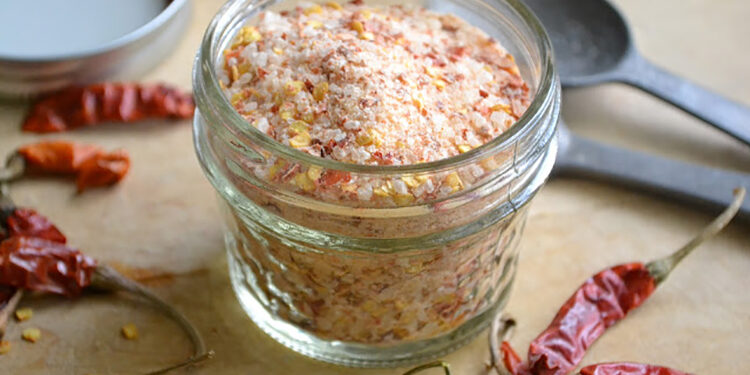Is is possible that salt can actually be good for you? I hope so…because I love my salt. As is the case with most foods that have a bad rap, it’s the processed version that is bad for our health. The minimally processed kind is more likely to contain the nutrients that nature intended it to. We all need a little daily salt in our diet. Salt has a bad rap and has become a health issue because it’s added to almost every food on the supermarket shelf to give it flavor. The key is to avoid processed convenience foods, and instead add a little healthy salt to your finished recipes.
Keep in mind that the flavor of salt is often lost in the cooking process, so rather than adding tons while you are cooking, you are better adding it when the dish is done. Salt is salt, however, it’s important to understand that the way that the salt is processed, and where it comes from, determines it’s taste, and nutritional value.
Here are the main different kinds of salt that you can buy:
Standard Table Salt is the stuff you want to avoid. Much like refined white sugar, it’s been stripped of any and all nutrients. Moreover, it has a host of unhealthy anti-caking additives thrown in too. Table salt is sodium chloride, which is an industrial product. It’s processed by being heated to extremely high temperatures, and then treated with caustic soda to remove any minerals.
What about “Iodized” Salt? If you look on the label of a box of table salt, the ingredient list will probably list Potassium Iodine as one of the ingredients. Iodine was added to salt in the 1920’s when it was discovered that the soil in some regions of the world were devoid of Iodine, and so the food grown there was also devoid. We need a little Iodine in our diets to prevent goiter and thyroid problems, however, most of us get it from fish, meat, dairy and some vegetables – it’s also naturally present in some good quality sea salts. If you are vegan, it’s a good idea to eat sea vegetables, which are a really good source of iodine. All this to say that you don’t need “Iodized” salt.
What about Kosher Salt? The only way that “Kosher” salt differs from table salt is the crystal size, which is typically favored by cooks because the multi-faceted crystals help to bring out the flavor of the food. Diamond Crystal Kosher salt is one of the most popular, and doesn’t have the additives that are added to other Kosher salts. BTW – it’s called “Kosher” because it was originally used for Koshering meat.
“Sea Salt” is typically minimally processed and still contains a myriad of trace minerals, which are really good for you. The differing tastes and colors of sea salt are determined by the region it came from. “Celtic” or gray salt is typically from France is is mined from ponds – it has a mild flavor, and can be quite expensive. A great sea salt is Real Salt, which is mined from an ancient salt bed (less pollution/more minerals) in Utah.
I love Himalayan Pink Salt for a number of reasons. It comes from the second largest salt mine in the world, which is located in Pakistan. It contains a number of healthy minerals, and it’s beautiful pink color comes from the Iron Oxide. It’s wonderful for gourmet cooking, and I also like to use it as a relaxing bath salt. Mountain Rose Herbs carries a great Himalayan Salt.
I love to make my own Flavored Salts, which is really easy. They make beautiful gifts, too. Here’s how:
You will need:
- A pretty 16- ounce glass jar with a cork lid
- 2 cups of Kosher salt
- 10 tsp (total) of flavoring agents
- A food processor
Simply add your flavorings and salt to your processor. Pulse until the added ingredients are almost in powder form, but do be careful not to pulverize salt (larger crystals is better). Pour into jar.
Flavoring Ideas:
- Matcha & Vanilla (great on chocolate ice cream). 4 tsp Matcha Tea, 4tsp pure Vanilla powder
- Saffron & Cumin (great for Moroccan Dishes) 4 tsp saffron threads, 4tsp cumin seeds
- Chocolate & Rose (great on vanilla ice cream and all kinds of desserts where you want something a little unusual). 4tsp dried rose petals, 4tsp cacao powder.
- Chili Lime (great on fish and veggies). 4 tsp of dried lime zest*, 4 tsp chili flakes
- Citrus Rosemary (this is my go-to for fish and grilled foods). 4 tsp of dried lemon zest*, 4 tsp dried rosemary*
- Porcini Mushroom 8 tsp dried porcini mushrooms.
* To dry the zest and herbs (very important that they are bone dry), grate the zest of 6 lemons/limes (for 4 tsp). If you are drying Rosemary, remove all the stalks before drying. Lay it out on a parchment-covered baking sheet. Place in your oven on the lowest heat possible for 2 hours, or after you’ve been cooking in your oven, turn it off and place the zest in there overnight.




Pingback: muberry willow tote review